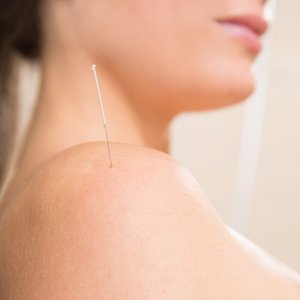
When you picture natural pregnancy tips to help relieve stress, you probably envision something along the lines of bubble baths, herbal tea, massages, and curling up in bed with a good book. The last thing you’d probably think of is long, thin needles. But maybe it’s time you did!
Acupuncture is a form of complementary care that uses needles placed in specific areas to provide pain relief and help treat physical, mental, and emotional conditions. The practice originated in ancient China and is widely accepted throughout the world today. Its focus is to fix imbalances and blockages of what Chinese medicine refers to as qi, or chi, which is the flow of vital energy along internal pathways in our bodies. There are more than 1,000 acupuncture points running along these many energy pathways. During an acupuncture session, these pathways are stimulated by the insertion of hair-thin needles.
The practice is safe and even beneficial for pregnant women, who can benefit from pain relief related to pregnancy symptoms, morning sickness, and fatigue. It can also help alleviate stress, induce labor, and even shorten the length of labor. Studies have even shown that it might impact fertility, especially when it comes to increasing the chances that an assisted reproductive technology like in vitro fertilization will result in success. So what else do you need to know about acupuncture during pregnancy? Read on to find out.
What it feels like
You might assume acupuncture hurts, but it’s actually quite soothing if you don’t have a problem with the idea of being pricked by needles. The typical Chinese fine needle measures .25 to .30 millimeters in diameter and 30 to 50 millimeters in length. They’re almost like a strand of hair. They’re not hollow or rigid, and the tip is shaped to increase comfort during insertion. Sometimes people don’t feel anything at all when the needles are inserted, and sometimes they do. It should never feel sharp, though—at most, it might feel like a mild mosquito bite. People describe the sensations they feel in a variety of ways, including achy, tingly, heavy, electric and warm. If it’s uncomfortable, all you have to do is let your acupuncturist know and he or she can alter the method being used.
How to find an acupuncturist
The best acupuncturists have years of graduate-level education on the subject and are licensed in their states. Look for one who’s board-certified by the National Certification Commission for Acupuncture and Oriental Medicine, which means the individual graduated from one of the most intensive educational programs for acupuncture in the U.S. You should also search for one who includes pregnancy treatment as a specialty. Look into your state’s licensing board, or the NCCAOM’s online directory.
When to go
Talk to your doctor to get help in deciding when the best time to start acupuncture treatment is. Some medical professionals think it’s best to wait until the second trimester, while others believe it’s best to start during the first when morning sickness and other symptoms tend to occur most. After you and your health care provider decide when to go, you’ll probably want to have regular appointments. It depends on your acupuncturist, but this may be every other week or every month—or more often when you’re nearing labor or if you have a specific ailment. Even after you deliver, you may want to continue treatment to help with fatigue and potential depression as you care for your new baby.
What to avoid
An acupuncturist who specializes in treating pregnant women will know which areas to avoid during treatment. This usually includes the lower back, certain points on the hands and shoulders, and areas around the lower leg and ankle. He or she will also likely refrain from inserting the needles too deeply.


I recently shared the story of my wife’s traumatic fall that occurred 3 weeks before delivering our first child 25 years ago and how I used osteopathic manipulative treatment (OMT) to help her recover from the fall and the low back pain. The reason I was motivated to share this was because my daughter (the passenger in my wife’s uterus 25 years ago) was on her first rotation as an osteopathic medical student and she got to see a patient who had delivered 7-days earlier and had lower back pain. Her supervising physician was not an osteopath and asked Samantha if she thought OMT would be helpful. Samantha’s response was an enthusiastic, “Yes!”
There’s been a lot of research since I treated my wife all those years ago. My hope is that sharing my story and the research will help people who are needlessly suffering. I also do Acupuncture and I’m supportive of its use during pregnancy, but both are even better when appropriately combined.
The YouTube story is I posted is: https://youtu.be/hLZT4GYFSTM